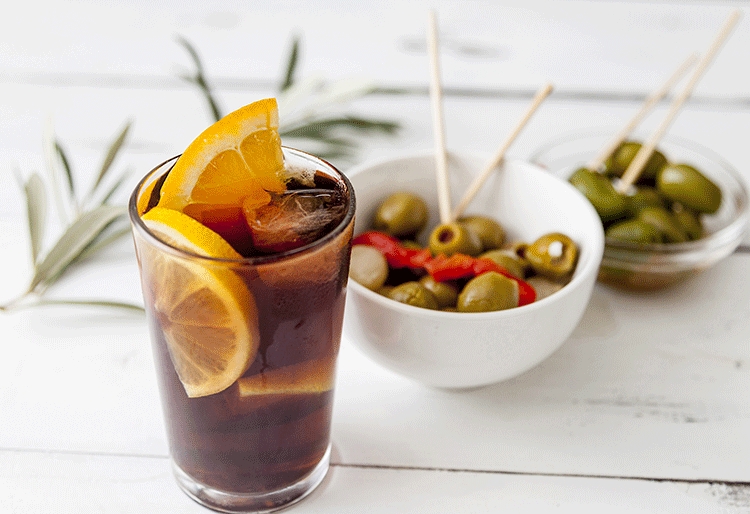How to make homemade vermouth
With our recipe you willlearn how to make homemade vermouth in a few simple steps to accompany yourfavorite appetizers. You will be surprised at the good result you can get
TRIED AND TESTED
Share

The base to make homemade vermouth is muscatel wine, sugar, alcohol, and aromatic substances such as herbs, leaves, and spices to personalize the flavor. Its alcoholic graduation usually ranges between 15º and 23º. Although vermouth can be consumed in various ways, the traditional one is on its own, with ice and a piece of orange peel, for reds, or lemon, for whites.
Vermouth was the quintessential appetizer in the 50s and 60s in our country until it was superseded by beer and other drinks. Today it returns to recover the lost prominence.
Origin and types of vermouth
The origin of vermouth dates back to ancient Greece, when Hippocrates macerated wine with wormwood, an essential plant used in its preparation. In fact, the word vermouth has German origin (Wermut) which means, precisely, absinthe. In 1786, the creators of the modern concept of vermouth were Antonio and Beneditto Carpano in Milan. Later, Martini & Rossi would turn it into a standardized product that we would enjoy in this way to this day.
Currently there are numerous types of vermouth, each one with its own personality and different from the rest, take note of them!
• Red vermouth: Originally from Italy, it is known as “Vermut rosso” or black. It is the most classic and common in Spain and also the sweetest because of the sugar or caramel that is added, so it is less bitter and dry than the rest, highlighting the aromatic herbs and spices, such as cinnamon.
• White vermouth: of French origin, it is similar to dry vermouth. In its elaboration, some of the herbaria and bitter substances that are used in the red are eliminated. It is the most consumed in the world, along with dry and usually has vanilla and citrus notes.
• Dry vermouth: known as "Dry Vermouth", it is also of French origin, which are the world's largest producers. It is used, especially, in cocktails to make the famous 'Dry Martini' and also in cooking. It is considered the most bitter vermouth.
• Rose: considered one of the smoothest, lightest and freshest vermouths, with floral and fruity notes, its popularity is relatively recent.
• Craft vermouths: made with a wide botanical variety (wormwood, savory, cinnamon, orange peel, gentian, cardamom, cloves, nutmeg, sage, coriander, star anise...) and different types of ageing.
• Non-alcoholic vermouth: instead of subjecting the ingredients to a fermentation process, maceration is used to capture the flavor, avoiding the alcoholic content.

Ingredients to make homemade vermouth
Do you want to learn how to prepare homemade vermouth? Take note of the ingredients you will need to prepare your vermouth.
• 2 liters of soft white wine
• 100 ml of vodka
• A small glass of muscatel
• The peels of one orange and one lemon
• 3 cinnamon sticks
• 8 cloves in spice
• 2 small tablespoons of wormwood
• A pinch of ginger (to taste)
• A pinch of nutmeg (to taste)
• Cardamom seeds (to taste)
• A sprig of fresh rosemary
• A bay leaf
• 3 or 4 tablespoons of brown sugar (to taste)
How to make homemade vermouth step by step
Preparation of homemade vermouth
• Choose the white wine you consider.
• In a saucepan, heat the wine together with the lemon and orange peels and the spices. Once it reaches the boiling point, turn off the heat and let it cool.
• Add the muscatel and vodka to the mixture.
• Add sugar to taste. We recommend you try the mixture until you get the desired flavor.
Homemade vermouth maceration
Believe it or not, this step is very important, because it is when you get that spicy flavor so characteristic of homemade vermouth.
• Once you have prepared your homemade vermouth, pour the content into a jar with a lid or glass jar. Keep it in a cold place in the house or in the fridge between 3 weeks and a month.
• Once macerated, strain your homemade vermouth with a strainer.
• Cool it again and… Enjoy!
Tapas to accompany your homemade vermouth
Is there anything better than learning how to make homemade vermouth? Yes, drink it accompanied by some tapas or pinchos, so typical of our country. Next, we leave you a list of tapas to accompany your homemade vermouth.
• Anchovies in vinegar
• Clóchinas with wine
• Starters with ham
• Coca tomato, sardines and olives






